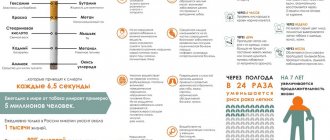VSD is a disease that includes a set of symptoms indicating a malfunction of the vascular system.
In modern medicine, vegetative-vascular dystonia is considered as a combination of various symptoms, and not as a separate disease. The main feature is that its symptoms cause illness throughout the body.
Before diagnosing VSD in a patient, the doctor must rule out other dangerous diseases.
Smoking is especially dangerous for VSD. Why and what this can lead to, we will consider in the article.
A smoker should know that smoking and VSD are incompatible. Nicotine puts a strain on the cardiovascular system, which is already suffering greatly.
Where does VSD come from?
Many experts agree that dystonia is a consequence of a psycho-emotional shock. After this, the general condition of the body deteriorates, which leads to a malfunction of all organs.
Causes:
- Emotional overload.
- Prolonged depression.
- Constant stress.
- Weak immune system.
- Physical overload.
- Insomnia.
- Problems with the spine.
- Smoking, alcohol and drugs.
General
There is no need to talk about how harmful a habit such as smoking is. We have all heard and read many times that smoking leads to lung cancer. In addition, the condition of the skin, hair and teeth deteriorates significantly. With VSD, smoking is especially dangerous, as it significantly undermines the functioning of the entire body. The chances of recovery in this case are practically reduced to zero.
Against the background of dystonia, which negatively affects the functioning of the nervous system, symptoms such as panic attacks, depression, and various phobic reactions may develop.
Smoking only worsens all these manifestations.
Many smokers, in order to calm down, smoke cigarette after cigarette, which saturates the body with harmful substances, which in turn has a detrimental effect on the body.
To summarize, we can say that smoking only worsens VSD, which can lead to irreversible consequences.
VSD after smoking
Despite the fact that many smokers claim that quitting smoking does not improve their condition in any way, but rather the opposite, this is far from true. Of course, one or two days will not change anything in the body. You need to understand that you have been smoking for a long time and have saturated your body with harmful substances. Accordingly, it will take a lot of time to remove them from the body.
Scientists have proven that giving up cigarettes improves the body's protective functions and brings them back to normal over time. Symptoms of VSD after quitting smoking begin to gradually recede.
What can you do to eliminate the symptoms of nicotine withdrawal?
To overcome tobacco addiction, you need to start treatment. To do this, you should make an appointment with a narcologist at a drug treatment clinic. The doctor will examine the addict and create an effective therapeutic program for him.
How successful the treatment will be directly depends on the following factors:
- Having a stable motivation to completely quit cigarettes. There is no point in being addicted to nicotine if there is no desire to recover. Very often people come to drug addiction specialists who have decided to give up tobacco precisely because of pressure from relatives. This approach to solving the problem is fundamentally wrong. If a person himself does not want to be treated, then no one can help him. Motivation is half the battle.
- Willingness to follow medical prescriptions. It is unacceptable to follow only those doctor’s instructions that seem simpler and more acceptable. All recommendations must be strictly followed. Then the craving for cigarettes will quickly subside.
- Willingness to immediately give up cigarettes completely. No need to throw slowly. Quitting cigarettes should be immediate. It is a myth that you need to prepare for it in a certain way. If necessary, the doctor will select replacement therapy, thanks to which the body quickly adapts to a decrease in the daily dose of nicotine. But the patient should not correct poor health with the help of regular smoking tobacco.
What is the danger of smoking with vegetative-vascular dystonia?
Smoking with a disease of the nervous system can be not only harmful, but also dangerous. This bad habit significantly worsens the condition of blood vessels, which in turn can lead to various diseases, as well as disrupt the functioning of the cardiac system as a whole.
Unfortunately, not all smokers can immediately pay attention to the symptoms of VSD. They are very similar to the negative manifestations of a heavy smoker. A person, perceiving such manifestations as a consequence of his negative habit, turns a blind eye to them. People consult a doctor, as a rule, in the later stages of the disease, when long-term and intensive treatment is already required and, accordingly, a complete renunciation of their addiction.
How to treat
The simplest, most obvious and effective way is to quit a bad habit. Well, or at least reduce the intake of nicotine into the body.
You can also try to compensate for the symptoms of vegetative-vascular dystonia. Doctors have developed a fairly effective three-stage treatment system for NCD, in which the level of therapy is determined by the severity of symptoms and organic manifestations of pathology.
But you can help yourself: if VSD is a maladaptation of the body’s systems, you can try to adjust the adaptive capabilities:
- Elimination or modification of predisposing, provoking factors (elimination of foci of chronic infection, elimination or reduction of stress, elimination of neurotoxic effects).
- Normalization of sleep/wake patterns.
- Hardening.
- Regular dosed physical activity (it will also provide invaluable support in the process of quitting smoking, stimulating the production of endorphins).
- Breathing exercises to relieve respiratory symptoms.
Take the smoking test
Smoking and disorder
A smoker with VSD must take into account a number of factors:
- Nicotine causes tachycardia. A healthy non-smoking person has a resting heart rate of 70 beats per minute. A person who smokes has a heart rate of 80-90 beats per minute. This, in turn, prevents the heart from filling with blood to the fullest extent.
- Carbon monoxide, which enters the body along with smoke, does not allow it to be saturated with oxygen. This negatively affects the functioning of all organs, especially the heart.
- Nicotine deals a large and often irreparable blow to the nervous system.
- A large amount of it affects the reduction of the hormone that is responsible for blood thinning - prostacyclin. Thanks to it, blood pressure decreases, which eliminates the formation of blood clots. The hormone is also responsible for normal vasoconstriction.
- All smokers have high cholesterol. This in turn leads to the formation of atherosclerotic plaques, which cause a heart attack or coronary heart disease.
- Nicotine also replaces acetylcholine. This is a substance that controls the cells and tissues of the body. Nicotine is similar to it in transmitting impulses, which confuses the organs. As a result, the smoker experiences chronic fatigue, feels irritable, begins to complain about memory, and becomes inactive. The body ceases to recognize acetylcholine and already needs nicotine, which, in principle, leads to addiction.
All these negative manifestations have a detrimental effect even on “healthy” smokers. And with vegetative-vascular dystonia, nicotine is not just harmful to health, but dangerous.
VSD and smoking
Vegetative-vascular dystonia is a very vague diagnosis. This disease is characterized by a set of symptoms that indicate disruptions in the autonomic nervous system. There are several forms of VSD, which manifest themselves in different ways. Everyone knows what smoking is. The main question: how is VSD and smoking combined? What consequences can this lead to?
Vegetative-vascular dystonia - causes and symptoms
This disease manifests itself differently in each person, not corresponding to the most pronounced manifestation of organ pathology. Manifestations of vegetative-vascular dystonia are divided into two types: vagotonia and sympathicotonia.
Vagotonia
This form of the disease is manifested by major hypochondria. A person's performance decreases and fatigue increases. In addition, sleep disorders and memory impairments are observed. People of this type are often indecisive, apathetic, fearful, and prone to depression. Sensitivity to stuffiness, cold, often a feeling of lack of air and chilliness, vestibular disorders, nausea and other symptoms. Cardiovascular disorders are manifested by bradyarrhythmia, pericardial pain, and decreased blood pressure.
Sympathicotonia
Such people are quick-tempered, temperamental, their mood is changeable, they are often distracted, often absent-minded, and neurotic states are observed. This symptomatology is characterized by a feeling of heartbeat and a feeling of heat. Such people suffer from pale and dry skin, pronounced white dermographism, numbness and paresthesia, poor heat tolerance, and atonic constipation. The heart suffers from tachycardia and high blood pressure.
How smoking affects cardiovascular activity
A smoker's heart beats faster (up to 80-90 beats per minute).
Carbon monoxide, which cigarette smoke brings into the body, reduces the amount of oxygen entering organs that are very important for life. Oxygen starvation has a very negative effect on the vital resource of the heart.
Increased blood clotting. Because of this, blood clots may appear in the blood vessels and heart cavity. If the blood clot breaks, and this almost always happens suddenly, the person may experience a myocardial infarction, cerebral stroke, or pulmonary infarction.
The negative effect is also due to the high concentration of nicotine, which affects the decrease in the level of the hormone prostacyclin and damage to cell membranes. A decrease in the level of this hormone can lead to a disease that affects the smoker's heart. It will also accelerate the course of an existing disease.
Cholesterol in the blood increases, and the level of blood lipids, betaliproprotein, also increases. This contributes to the formation of atherosclerotic plaques, which prevent blood flow to the heart. The negative consequences of atherosclerosis are myocardial infarction, ischemic disease and even sudden death.
Consequences of smoking with VSD (vegetative-vascular dystonia)
One of the most sensitive systems of the body during VSD is the cardiovascular system and the heart. Therefore, VSD and smoking are a dangerous combination.
Spasms
After smoking a cigarette, the heart muscle works faster, blood pressure rises and pulse increases. Small blood vessels under the influence of nicotine undergo a spasm that lasts about half an hour. This means that if you smoke frequently, your blood vessels are in constant spasm, which prevents normal blood flow to tissues and organs. There is a risk of developing myocardial infarction and hypertension.
Negative manifestations after smoking one cigarette
One of the dangerous manifestations may be an increase in blood pressure, which can lead to a stroke. Even after one cigarette, the smoker begins to experience tachycardia and vasoconstriction.
Smokers also often experience panic attacks and psycho-emotional agitation.
Even after one puff, arrhythmia and dizziness may occur.
A smoker suffering from dystonia should be aware that the symptoms of VSD are significantly aggravated by smoking.
Subsequently, the smoker finds himself in a vicious circle, which leads to exhaustion of the nervous system. Stress and tension force a person to smoke cigarette after cigarette, which further worsens the course of the disease. Over time, the “snowball” grows, and stopping it becomes simply unrealistic.
Consequences of quitting smoking
The first signs of withdrawal may occur on the first day of quitting smoking. Despite the initial discomfort, the decision to quit smoking has a positive effect on a person’s health: quitting smoking will help restore the health of the respiratory, cardiovascular and nervous systems. Having survived the difficult period of withdrawal syndrome, you can completely give up cigarettes, replace them with a healthy diet, physical activity and active recreation.
Quit smoking - blood pressure went down
Often, after giving up cigarettes, the addict becomes weak and dizzy. The fact is that with prolonged smoking, nicotine plays the role of a stimulant in the body, increases heart rate and increases blood pressure. As a result of hypertension, the smoker gets feverish, hand tremors occur, and it becomes difficult to breathe.
To increase blood pressure, some people drink caffeinated drinks. This decision has a detrimental effect on the cardiovascular and nervous system, and the stimulating effect of coffee quickly wears off. Consult your doctor to replace nicotine with “healthy” stimulants, such as eleuthero, ginseng decoction, etc.
Quit smoking - headache, dizziness, drowsiness
Drowsiness and dizziness in smoker's syndrome are associated with a drop in blood pressure and a decrease in the overall tone of the body. In addition, headaches and dizziness when quitting cigarettes are often associated with the launch of “reverse processes”: the body is intensely saturated with oxygen, which can lead to unpleasant conditions. This symptom disappears a few days after quitting cigarettes.
Headache after smoking occurs as a result of cerebral vascular spasm: this is a dangerous condition that can lead to a stroke. This means that deciding to quit smoking will help manage chronic migraines and prevent the onset of acute migraines.
Quit smoking - back hurts
In some cases, during nicotine withdrawal, the skin on the back itches and pain in the spine is noted. This is due to the following reasons:
- Nervousness contributes to muscle strain, resulting in pain;
- Psychosomatics. The expectation of physical discomfort contributes to its appearance: as a result of “self-programming,” a person’s legs ache, back discomfort appears, and the temperature may even rise;
- Painful symptoms may indicate the presence of a disease of the musculoskeletal system. Surprisingly, nicotine can block some pain impulses that signal back problems. Its absence simply reveals pathology.
Regardless of the intensity of the pain, if it occurs, you should consult a doctor. Early detection and treatment of diseases will help prevent their development.
Find out treatment recommendations without leaving home for free
To select a treatment plan, you just need to leave a request, we will contact you to select the time and specialist you need
Submit your application
Nasal congestion
Nasal congestion is a common symptom of nicotine withdrawal. Nicotine promotes vasodilation, and its absence causes vasoconstriction. The fact is that due to an imbalance in the ratio of oxygen and carbon dioxide in the body, swelling of the nasal mucosa (stuffiness) occurs.
This may be accompanied by swelling of the face, bleeding from the nose, bad breath, etc. A good way to get rid of congestion is to visit an ENT specialist, use special drops and start exercising to improve oxygen metabolism.
Depression when quitting smoking
It is widely believed that cigarettes are the smoker's main sedative. In fact, nicotine is a powerful stimulant of the nervous system, supporting its functioning. After quitting smoking, a person feels drowsiness, weakness in the legs and a depressed mood. This occurs due to changes in biochemical processes in the brain. If depression develops, you must do the following:
- Contact a psychiatrist-narcologist. Specialists will help reduce the intensity of withdrawal symptoms and improve a person’s well-being. The doctor will prescribe high-quality antidepressants and prescribe psychotherapy;
- Fight anxiety with the right methods: meditate, switch your attention to a healthy lifestyle.
Sore throat, lump in throat, pain
During the period of abstinence, the addict’s body is cleansed of accumulated combustion products: toxins and other aggressive substances are eliminated through the throat, contributing to the appearance of pain impulses. Sore throat and pharyngitis develop: symptomatic treatment is necessary. The pain and feeling of a lump in the throat go away after some time after quitting smoking.
A sore throat while smoking is associated with drying of the mucous membrane of the throat: pharyngitis develops. As a result, local immunity decreases and the incidence of infectious diseases increases. If dryness occurs after quitting smoking, it is worth visiting an ENT specialist, performing herbal inhalations and rinsing the throat.
Panic attacks when quitting smoking
A panic attack is a serious condition that is accompanied by severe horror and panic. A panic attack can be caused by exposure to “triggers” (irritants), or occur on its own. During withdrawal, the functioning of the nervous system is restructured, which can lead to panic attacks. In order to help yourself during a panic attack, it is not enough to take Afobazol and other pharmaceuticals: you should consult a specialist to study the causes of panic attacks and their treatment.
Lost appetite, loss of strength
Poor health and loss of appetite are caused by a decrease in body tone. Relief from this syndrome should be carried out in combination with comprehensive treatment of nicotine addiction and abstinence.
I quit smoking and have chest pain
Chest pain is also associated with self-cleansing: the respiratory system removes toxins, tars and other harmful elements in order to normalize function. Natural detoxification is accompanied by night sweats, weakness, coughing and chest pain. During this period, you can help yourself in this way:
- Try to drink still water more often;
- Take a walk in the fresh air;
- Consume more protein foods;
- Avoid secondhand smoke.
How does smoking affect the heart in VSD?
As we found out earlier, nicotine affects the walls of blood vessels, and carbon monoxide limits the flow of oxygen into the body. As a result, all resources of the cardiac system gradually begin to deplete.
One of the dangerous symptoms is increased blood clotting, which can inevitably lead to stroke, myocardial infarction or pulmonary infarction. Increased nicotine levels lead to increased cholesterol levels, and this, in turn, leads to the formation of atherosclerotic plaques.
Experts say that the combination of VSD and smoking sooner or later leads the smoker to a hospital bed in the cardiology department.
Respiratory system diseases
Very often, dystonia leads to breathing problems. A person who smokes feels all the negative symptoms of this disease several times more strongly:
- Lack of oxygen.
- Heavy breathing after smoking a cigarette.
- Dizziness from lack of oxygen.
As a result of nicotine abuse, a disease such as bronchial asthma can develop.
The connection between smoking and panic attacks in VSD
We all know about the negative effects of nicotine on the body. But not all smokers understand how serious the problem can be.
Not many people know that most cases of panic attacks are associated with such a bad habit as smoking.
Smoking during VSD and panic attacks greatly increases the chances of a heart attack and is strictly prohibited.
Without going into the details of psychopharmacology, it can be noted that nicotine increases the level of adrenaline and glutamate. This is what leads to a “narrowing of consciousness.”
This condition is especially aggravated by abrupt cessation of cigarettes. The condition may be similar to when a person smokes a cigarette with narcotic components or, as people call it, “weed.”
Properly selected medications will help you get rid of not only PA, but also a bad habit. Anti-anxiety medications are prescribed first. They will help the smoker not only get rid of the main problem, but also ease the course of VSD. At the next stage, the patient should be prescribed medications aimed at combating smoking. A method of gradually reducing the dosage will be effective and less traumatic for the psyche. Abrupt withdrawal from nicotine will lead to destabilization of the functioning of all organs. To prevent the body from experiencing such stress, you can seek help from a patch, nicotine tablets or electronic cigarettes. These supplements will provide only a small amount of nicotine into the body, gradually reducing its level.
The help of a qualified specialist will not be superfluous. High-quality psychotherapy with the elaboration of all problems will help you quickly and least stressfully cope with the problem of smoking, neurosis, PA and VSD.
Just as with PA, VSD, smoking with neurosis is especially contraindicated. Many smokers are misled into thinking that cigarettes help them cope with stress. Nicotine only masks the main symptoms of the disease, driving them inside.
What does a person expect when he quits smoking?
The man smoked for many years. Of course, he already understood that smoking is a bad habit. And then the doctor said that if you don’t quit, your heart will not hold up or your lungs will fail, or the implant cannot be placed. And so the man decided that it was time to seriously quit smoking.
The person understands that it may not be easy at first. But, after all, he stops constantly poisoning his body. And the body, in the end, must respond with gratitude. A person expects easier breathing, a lift in mood, and a surge of strength.









